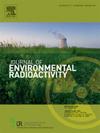基于点核积分快速耦合法的机载伽马三维辐射场正演计算。
IF 1.9
3区 环境科学与生态学
Q3 ENVIRONMENTAL SCIENCES
引用次数: 0
摘要
航空伽马能谱探测技术是测量航空飞行过程中地表岩石、土壤等环境介质中天然放射性核素浓度和空间分布的有效手段。因此,充分挖掘航空伽马能谱数据中与矿化相关的辐射信息,探索探测区域放射性核素伽马辐射场的剂量分布规律至关重要。本文建立了地空界面伽马辐射场的理论计算模型。将不规则均匀分布的放射性核素地质体等效面源离散成网格后,将其划分为大小、密度、各向同性均匀的差分面源。建立了地气界面差分源空间辐射场的理论计算模型。最后,利用Qt框架开发了不规则面源耦合点源的三维辐射场快速计算程序。通过三个算例验证了该程序的准确性和效率。对于单个规则面源,矩形面源在大多数测点上表现出较高的一致性。平均相对偏差为9.183%。在圆形表面源的情况下,两种方法之间的剂量率值在边缘区域偏差较大,而在中心区域偏差较小。平均相对偏差为12.765%。对比两种不规则面源模型的计算数据,快速计算程序比SuperMC程序快几十倍。最大相对偏差为38.245%,最小相对偏差为5.416%,计算精度较高。平均相对偏差为21.912%。在几种不规则地表源模型上,相对偏差较大。最大相对偏差为52.234%,最小相对偏差为12.305%,平均相对偏差为28.126%。本研究可为相关领域的研究人员提供一定的理论参考,促进机载伽马辐射场技术的发展和应用。本文章由计算机程序翻译,如有差异,请以英文原文为准。
Forward calculation of airborne gamma 3D radiation fields based on rapid coupling method of point kernel integrals
Airborne gamma ray spectrum detection technology is an effective means to measure the concentration and spatial distribution of natural radionuclides in environmental media such as surface rocks and soil during aviation flight. Therefore, it is vital to fully explore the radiation information related to mineralization in airborne gamma spectrometry data and explore the dose distribution law of gamma radiation field of radionuclides in the detection area. This paper is based on the theoretical calculation model of ground-air interface gamma radiation field. After discretizing the equivalent surface source of the geological body with irregular and uniformly distributed radionuclides into a grid, it is divided into differential surface sources of uniform size, density, and isotropy. A theoretical calculation model for the spatial radiation field of differential surface sources at the ground-air interface has been derived. Finally, a rapid calculation program for the 3D radiation field of irregular surface sources coupled with point sources has been developed using the Qt framework. The accuracy and efficiency of the program were tested through three examples. For a single regular surface source, the rectangular surface source exhibited higher consistency at most detection points. The average relative deviation was 9.183%. In the case of a circular surface source, the dose rate values between the two methods deviated more significantly in the edge regions but less so in the central region. The average relative deviation was 12.765%. When comparing the calculation data of two irregular surface source models, the rapid calculation program was dozens of times faster than the SuperMC program. The maximum relative deviation was 38.245%, the minimum relative deviation was 5.416%, and the calculation accuracy was high. The average relative deviation was 21.912%. On several irregular surface source models, the relative deviations were relatively large. The maximum relative deviation reached 52.234%, the minimum was 12.305%, and the average relative deviation was 28.126%. This study can provide a certain theoretical reference for researchers in related fields, promoting the development and application of airborne gamma radiation field technology.
求助全文
通过发布文献求助,成功后即可免费获取论文全文。
去求助
来源期刊

Journal of environmental radioactivity
环境科学-环境科学
CiteScore
4.70
自引率
13.00%
发文量
209
审稿时长
73 days
期刊介绍:
The Journal of Environmental Radioactivity provides a coherent international forum for publication of original research or review papers on any aspect of the occurrence of radioactivity in natural systems.
Relevant subject areas range from applications of environmental radionuclides as mechanistic or timescale tracers of natural processes to assessments of the radioecological or radiological effects of ambient radioactivity. Papers deal with naturally occurring nuclides or with those created and released by man through nuclear weapons manufacture and testing, energy production, fuel-cycle technology, etc. Reports on radioactivity in the oceans, sediments, rivers, lakes, groundwaters, soils, atmosphere and all divisions of the biosphere are welcomed, but these should not simply be of a monitoring nature unless the data are particularly innovative.
 求助内容:
求助内容: 应助结果提醒方式:
应助结果提醒方式:


